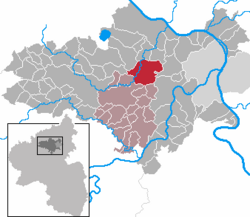Ochtendung
Ochtendung | |
|---|---|
 Coat of arms | |
Location of Ochtendung within Mayen-Koblenz district  | |
 Ochtendung Show map of Germany  Ochtendung Show map of Rhineland-Palatinate | |
| Coordinates: 50°20′53″N 7°23′23″E / 50.34806°N 7.38972°E / 50.34806; 7.38972Coordinates: 50°20′53″N 7°23′23″E / 50.34806°N 7.38972°E / 50.34806; 7.38972 | |
| Country | Germany |
| State | Rhineland-Palatinate |
| District | Mayen-Koblenz |
| Municipal assoc. | Maifeld (Verbandsgemeinde) |
| Government | |
| • Mayor | Rita Hirsch (SPD) |
| Area [1] | |
| • Total | 24.05 km2 (9.29 sq mi) |
| Elevation | 200 m (700 ft) |
| Population (2017-12-31)[2] | |
| • Total | 5,423 |
| • Density | 230/km2 (580/sq mi) |
| Time zone | CET/CEST (UTC+1/+2) |
| Postal codes | 56299 |
| Dialling codes | 02625 |
| Vehicle registration | MYK |
| Website | www.ochtendung.de |

Microphotograph of pseudobrookite (Mindat) mineral specimen, Wannenköpfe, Ochtendung. Image width 2.5 mm.
Ochtendung is a municipality in the district of Mayen-Koblenz in Rhineland-Palatinate, western Germany.
Contents
1 Geography
2 Municipal Division
3 Etymology
4 Archeology
5 Politics
6 Sights and Tourism
7 Famous residents
8 Sources
9 References
Geography
Ochtendung lies between the A 48 and A 61 motorways and has designated junctions from both. The village lies on the Nette and is neighboured by the municipalities of Lonnig, Bassenheim, Plaidt, Kruft and Saffig. Up until a few years ago, the B 258 road started in Koblenz before running through Ochtendung and Mayen towards Belgium, passing the Nürburgring. The stretch between Koblenz and Mayen was regraded due to the proximity to the A 48 and has since been the L 98.
Municipal Division
The districts Alsingerhof, Emmingerhof, Fressenhöfe Waldorferhof and Sackenheimerhöfe (previously a Bassenheim district) make up the municipality of Ochtendung.
Etymology
The name of the village is derived from the word Thing or Ding (Ochtendung).
A 'Thing' was a governing assembly in Germanic societies.
Archeology
The south east area of the Eifel region is a veritable treasure trove for archeologists. In 1997, Axel von Berg found the cranium of a Neanderthal along with three stone artefacts by the 'Wannerköpfe' volcano in 1997. The cranium belonged to an adult man (some 35 – 40 years old) and had been broken into three pieces due to the pressure of the Earth, but these were seamlessly put back together.
Dated at some 160,000 to 170,000 years old, the man belonged to the early Neanderthals. Especially interesting is the closeness of the bones to those of homo erectus and because, around the edge there appear to be traces of human handling. It can be guessed that they were adapted and used as tools or bowls. The cranium was quickly covered by sediment and has therefore been well preserved.
Politics
The Gemeinderat (comparable to the town council in English) of Ochtendung consists of 22 council members, voted in after the local elections of 7 July 2009 and headed by the Ortsbürgermeister in a voluntary position, as per the custom in the state of Rhineland Palatinate for village municipalities. This position is similar to the position of a town mayor.
The allocation of seats after the election is as follows:
SPD 11 seats
CDU 7 seats
FWG1 2 seats
WG Ich tu's (I do it) 2 seats
Sights and Tourism
- Wernerseck Castle
Karmelenberg, a volcanic cinder cone
Kulturhalle Ochtendung, used for holding special events- Remains of the town wall
- Cycle and Sculpture Trail between Ochtendung and Polch
Famous residents
Jakob Vogt (1902–1985) Weightlifter
Jürgen Weigt (born 1957) Brigadier in the German Army
Peter Peters (born 1962) Journalist and football Functionary
Kristin Silbereisen (born 1985) Table Tennis Player
Sources
Human Evolution, 19,1 S. 1 - 8 (2004)
Terra Nostra, Schriften der GeoUnion Alfred-Wegener-Stiftung, 2006/2 (Kongresszeitschrift)
Dr. Axel von Berg's discovery (German Only)
Local Election Results 2009 (German Only)
References
^ "Alle politisch selbständigen Gemeinden mit ausgewählten Merkmalen am 31.12.2018 (4. Quartal)". DESTATIS. Archived from the original on 10 March 2019. Retrieved 10 March 2019..mw-parser-output cite.citation{font-style:inherit}.mw-parser-output .citation q{quotes:"""""""'""'"}.mw-parser-output .citation .cs1-lock-free a{background:url("//upload.wikimedia.org/wikipedia/commons/thumb/6/65/Lock-green.svg/9px-Lock-green.svg.png")no-repeat;background-position:right .1em center}.mw-parser-output .citation .cs1-lock-limited a,.mw-parser-output .citation .cs1-lock-registration a{background:url("//upload.wikimedia.org/wikipedia/commons/thumb/d/d6/Lock-gray-alt-2.svg/9px-Lock-gray-alt-2.svg.png")no-repeat;background-position:right .1em center}.mw-parser-output .citation .cs1-lock-subscription a{background:url("//upload.wikimedia.org/wikipedia/commons/thumb/a/aa/Lock-red-alt-2.svg/9px-Lock-red-alt-2.svg.png")no-repeat;background-position:right .1em center}.mw-parser-output .cs1-subscription,.mw-parser-output .cs1-registration{color:#555}.mw-parser-output .cs1-subscription span,.mw-parser-output .cs1-registration span{border-bottom:1px dotted;cursor:help}.mw-parser-output .cs1-ws-icon a{background:url("//upload.wikimedia.org/wikipedia/commons/thumb/4/4c/Wikisource-logo.svg/12px-Wikisource-logo.svg.png")no-repeat;background-position:right .1em center}.mw-parser-output code.cs1-code{color:inherit;background:inherit;border:inherit;padding:inherit}.mw-parser-output .cs1-hidden-error{display:none;font-size:100%}.mw-parser-output .cs1-visible-error{font-size:100%}.mw-parser-output .cs1-maint{display:none;color:#33aa33;margin-left:0.3em}.mw-parser-output .cs1-subscription,.mw-parser-output .cs1-registration,.mw-parser-output .cs1-format{font-size:95%}.mw-parser-output .cs1-kern-left,.mw-parser-output .cs1-kern-wl-left{padding-left:0.2em}.mw-parser-output .cs1-kern-right,.mw-parser-output .cs1-kern-wl-right{padding-right:0.2em}
^ "Bevölkerungsstand 2017 - Gemeindeebene". Statistisches Landesamt Rheinland-Pfalz (in German). 2018.